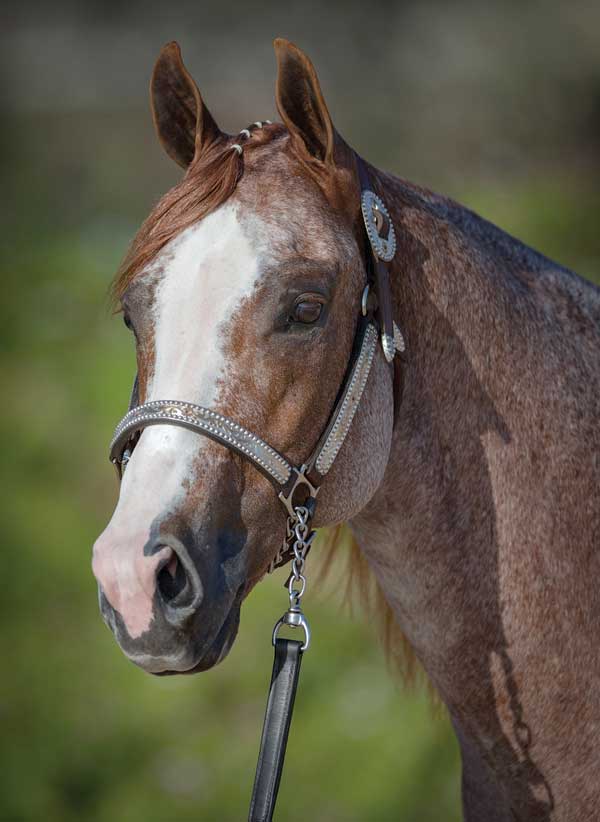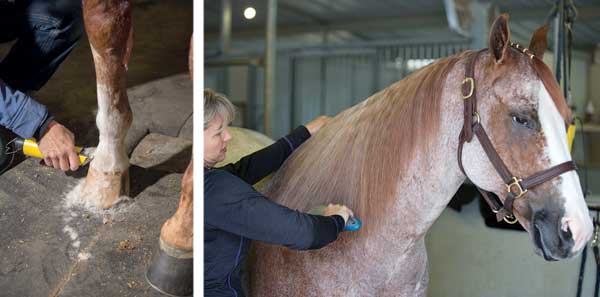First impression: It’s that moment when a judge gets his initial look at you and your horse when you walk into the show pen. A positive one can help set the tone for the rest of your performance. One simple way to do that is to make sure your horse looks his best.

How? With a little time and elbow grease, some inexpensive grooming products, and these nine tips.
The Prep
Tip #1: Start with a clean horse. Bathe your horse’s body, then shampoo and condition his mane and tail. Not only will his coat look its best, but you’ll also help minimize wear and tear on your clippers. (There’s nothing like a dirty horse to wreck a set of clipper blades!) Let him dry completely.
Tip #2: Clip your horse’s legs. Clipped legs provide a clean, crisp look. They’re also easier to keep clean than hairy legs. We use #10 blades on low white socks, for a close, clean clip. (Note: To be safe, clip your horse’s legs about a week before your show. That way, the hair can grow back slightly, minimizing any sign of clipper tracks.)
If your horse has high white stockings, use #7 or #8 blades (the lower the number, the coarser the blades). Such blades provide a slightly longer cut that still looks tidy, but is less likely to cause razor burn or irritation, especially if you use protective leg boots. (Note: If you’re not good at clipping, longer-cut blades are more forgiving than closer-cut ones, because they’re less likely to leave tracks.)
Also use #7 or #8 blades to clip around your horse’s coronary bands, as well as his fetlocks and pasterns, to provide a crisp, clean look.
Tip #3: Clip your horse’s face and ears. Use #40 (surgical) blades to clip your horse’s ears, muzzle, eyebrows, and bridle path. Switch to a #10 blade to clip the long hairs under his jaw. Once you’ve clipped his ears, apply some rubbing alcohol to a moistened towel and wipe them out. Doing so provides a more hygienic ear environment, as well as a polished look.
Tip #4: Smooth his hooves. Using 250-grit sandpaper, lightly go over your horse’s hooves to smooth out ridges. Follow up by buffing with 400-grit sandpaper, to create a smooth, even surface. (Note: Some people consider sanding a horse’s hooves to be unhealthy. Perhaps if you sand off too much surface that could be the case. But if you’re just smoothing it out, you’re unlikely to damage the hoof wall.)

Tip #5: Polish his hooves. If within the rules of your breed or sport group, apply a hoof-shine product to your horse’s hooves, for a clean, polished look. (I’d suggest wearing gloves, as this can be messy!) Using the dauber, start with a line along the coronary band. Continue applying even horizontal lines, until you reach the toe. (You may want to practice once or twice at home before doing this at a show.) Remove the polish after you’ve finished showing, using a product designed for this purpose.
Tip #6: Oil your horse’s face. Use an oil-based shine product on a towel or rag to highlight the black points around your horse’s muzzle, eyes, and inside his ears. (Note: Tinted shine products are available. Be sure to check with your breed association before using one, as some associations forbid them.) Don’t over-do—less can be best. Your goal is to highlight, not saturate!
Tip #7: Shine and smooth your horse’s mane. Apply a small amount of shine/detangling product to your fingers, and run them through your horse’s mane, to smooth down the hairs. Then brush or comb his mane, working from the bottom (the ends) to the roots. (Note: Avoid brushing or combing a wet mane or tail, which can result in stretching and pulling out hairs. Instead, allow the hair to air dry after you’ve washed and conditioned it. And always apply detangler before you brush.)
Tip #8: Shine and smooth his tail. Repeat #7 on your horse’s tail. We keep our horses’ tails braided when we’re not showing. That way, we don’t have to brush them every day and can minimize hair breakage. You can also use a tail bag or a sock to protect the tail hairs. However, you have to check the tail daily—if the bag or sock starts looking dirty and frayed, and/or starts coming undone, it’s been on too long and may cause more damage than it prevents.
Tip #9: Apply shine to his body. Use an oil-based coat-shine spray to give extra sheen to your horse’s coat, just before you show. (If you’re showing in a super dusty facility, opt for a dust-repellant coat-shine product, instead.) And now you’re ready to go—and win!
A multiple AQHA world champion, Avila has also won three NRCHA Snaffle Bit Futurities, the NRHA Futurity, and two World’s Greatest Horseman titles. He received the AQHA Professional Horseman of the Year honor. His Avila Training Stables, Inc., is in Temecula, California. Learn more at bobavila.net.






